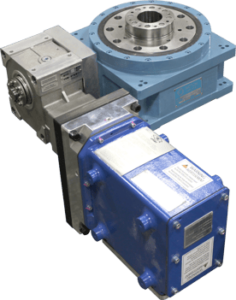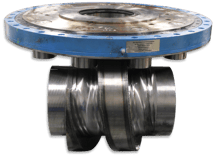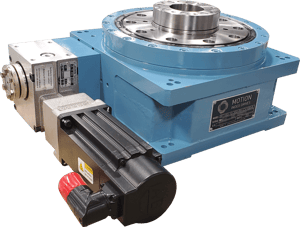HOW DO YOU SELECT A ROTARY INDEX DRIVE?
Selecting a rotary indexing machine isn’t always an easy process, especially when on a tight budget. Rotary index drives are used widespread in automated assembly machinery environments, and it is necessary to select a machine that fits in well with the requirements of the application it is being used in.

THE RIGHT INDEX DRIVE WILL MEET THE PHYSICAL REQUIREMENTS OF THE APPLICATION:
- Taking into account the weight load of the components being moved as well as the inertia effects of starting and stopping with the masses involved.
- Taking into account the behavior requirements of acceleration and dwell times to meet the automation goals.
- Taking into account integration and synchronization with other machines, whether they be on-boarding or off-boarding parts or performing an operation such as filling or machining.
Before selecting a rotary index drive, it is important to understand different types of tables and their strengths and limitations. Most can be broken up into two categories, indexing tables with cam indexers and indexing tables driven by servo motors.
CAM INDEXERS INDEXING TABLE
Cam indexers, as their name suggests, use a mechanical cam with a machined mathematical motion curve to provide smooth and repeatable motion to position the table so that tasks may be performed. This is a proven, typically less expensive design that has been used for decades, and is quite accurate and highly precise, but is limited to a fixed set of angles that can be indexed to.

There are two types of indexing motion within the category of cam indexers, cycle-on-demand and continuous mode.
Cycle-on-demand cam indexing refers to a type of cam that doesn’t have a dwell machined into the mathematical motion curve of the cam, the motion curve of one revolution of the cam moves the table one indexing position. This type of cam indexing simply starts the motor when the table needs to be indexed to the next position, then stops it for however long is necessary to complete the task, with the dwell simply occurring when the motor is turned off. This is more advantageous for processes with a long dwell period followed by quick indexing.
Continuous mode refers to more traditional cams that spin continuously at a constant speed, with the dwell of the indexing table machined into the mathematical motion curve on the cam. This is useful when other equipment may also be synched up with the camshaft timing or when the indexing will occur too quickly for the motor to be stopped and started, as in cycle-on-demand indexing. This type of cam indexing can achieve rates of greater than 1000 cycles per minute, and is only limited by the design of the cam.
SERVO ROTARY TABLE INDEXING TABLE
Servo indexing tables are the most common alternative to cam indexing tables, offering two main situations when they are advantageous. One such situation is when a flexible motion pattern is needed, such as when two products are run on one machine, potentially requiring two different indexing patterns. The other situation is when extremely fast indexing is followed by a long dwell. This situation is similar to one in which a cycle-on-demand cam indexer would be used, but cycle-on-demand cams need to accelerate the camshaft up to speed during the dwell before the output motion is started, sometimes limiting their capability to index the table quickly enough. On the other hand, servo motors deliver torque and output almost instantaneously, allowing for very fast indexing followed by long dwell periods.

APPLICATIONS OF INDEXING TABLES
When selecting indexing tables, it is vital that the application and location of the table be considered. There are several specifications that vary by application that decide which table is best suited for the application.
Some tables are more accurate and consistent in their positioning than others. The required accuracy will vary by application, with some applications tolerating +/- ¼” and some requiring accuracy down to microns. Cams are limited by their ability to only index to set positions, but are considered the most consistent and accurate of the indexers.
Backlash in the indexing system is an important factor to consider when selecting a table, especially in applications with many cycles per minute. It is important to know how quickly the movement of mass can be started and stopped, as quick starting and stopping can result in back and forth motion within a gearing system, causing vibration(backlash) that is impossible to predict or account for. Another factor impacting backlash is the size of the table, as the further from the center of rotation the mass is, the more backlash is magnified. Cam indexers are the best indexers when backlash would be an issue, as they are rigid, controlled systems with stop times in the milliseconds but little to no backlash.
Mass moment of inertia is the most important factor in table selection, as the size of the table will be determined by the mass moment of inertia and speed of operation. Many manufacturers equate rotating mass to pushing mass, causing incorrect calculations that can lead to total failure of a table. If mass moment of inertia isn’t properly taken into account, failure can occur that leads to downtime, meaning the indexing table will hinder productivity rather than helping it.
Many applications require high acceleration and deceleration rates, however, if these rates are too high either the table may not be able to accommodate the demand, or components outside the motor(such as the transmission) may experience stress or even failure. Servo tables are the tables with the best acceleration due to their instantaneous torque delivery, but upon rapid deceleration they can experience backlash.
The environment that the tables are used in also needs to be taken into account when selecting tables, as some environments can be too harsh for standard indexing tables. For example, tables used in food production facilities often require either nickel plated or stainless steel parts, as the wash-down chemicals used in these facilities can corrode standard steel. Proper seals with corrosion resistance are also necessary so that none of the wash-down chemicals get inside the table and damage the motor or transmission. Fine metal dust in foundries can also penetrate standard sealing systems, potentially leading to dust entering the oil and wearing on bearings, cam followers and gears.
The final specification determining table selection is the required speed of the indexing table. High speeds are often at the top of customers’ wish lists for their table, as they want to increase production speeds as much as possible with these indexing tables. This can be quite expensive, however, as mass moment of inertia also needs to be taken into account when speed is increased, and may lead to a larger table being necessary for such speeds. Attaining higher speeds with these tables can end up being quite expensive, meaning that it must be absolutely mandatory that a high speed be met if a customer requests it, otherwise the table may end up being too expensive. Both servo motors and continuous cams can be a good choice in high speed applications, with servo motors delivering better acceleration but continuous cams delivering high speeds at lower costs.
Selecting the right indexing table can be a costly process, but it can drastically improve production levels. Ensuring that the right table is selected is incredibly important if a company wants to maximize efficiency and avoid downtime, and if the wrong table is purchased, downtime events may occur repeatedly until the proper table is purchased to replace it.
Read our Guide to Rotary Index Tables learn more about Indexing Tables.
Interested in making sure that you get the right indexing table for your application? Get our guide below!

